Social Psychology: An Analysis of the Theory of Planned Behavior
VerifiedAdded on 2019/11/14
|10
|2876
|398
Essay
AI Summary
This essay provides a detailed analysis of the Theory of Planned Behavior (TPB) within the field of social psychology. It begins by introducing the TPB, explaining its origins and core components, including attitudes, subjective norms, behavioral intentions, social norms, perceived behavioral control, and perceived power. The essay then explores the theory's application in predicting and explaining various behaviors, particularly those related to health, such as exercise and diet, and discusses its contribution to understanding participation in exercise and physical activity, especially among older adults. It offers a critical evaluation, presenting both the strengths and limitations of the TPB in explaining attitude-behavior relationships. The essay concludes with a summary of the theory's current status and research, highlighting its continued relevance in understanding and influencing human behavior.
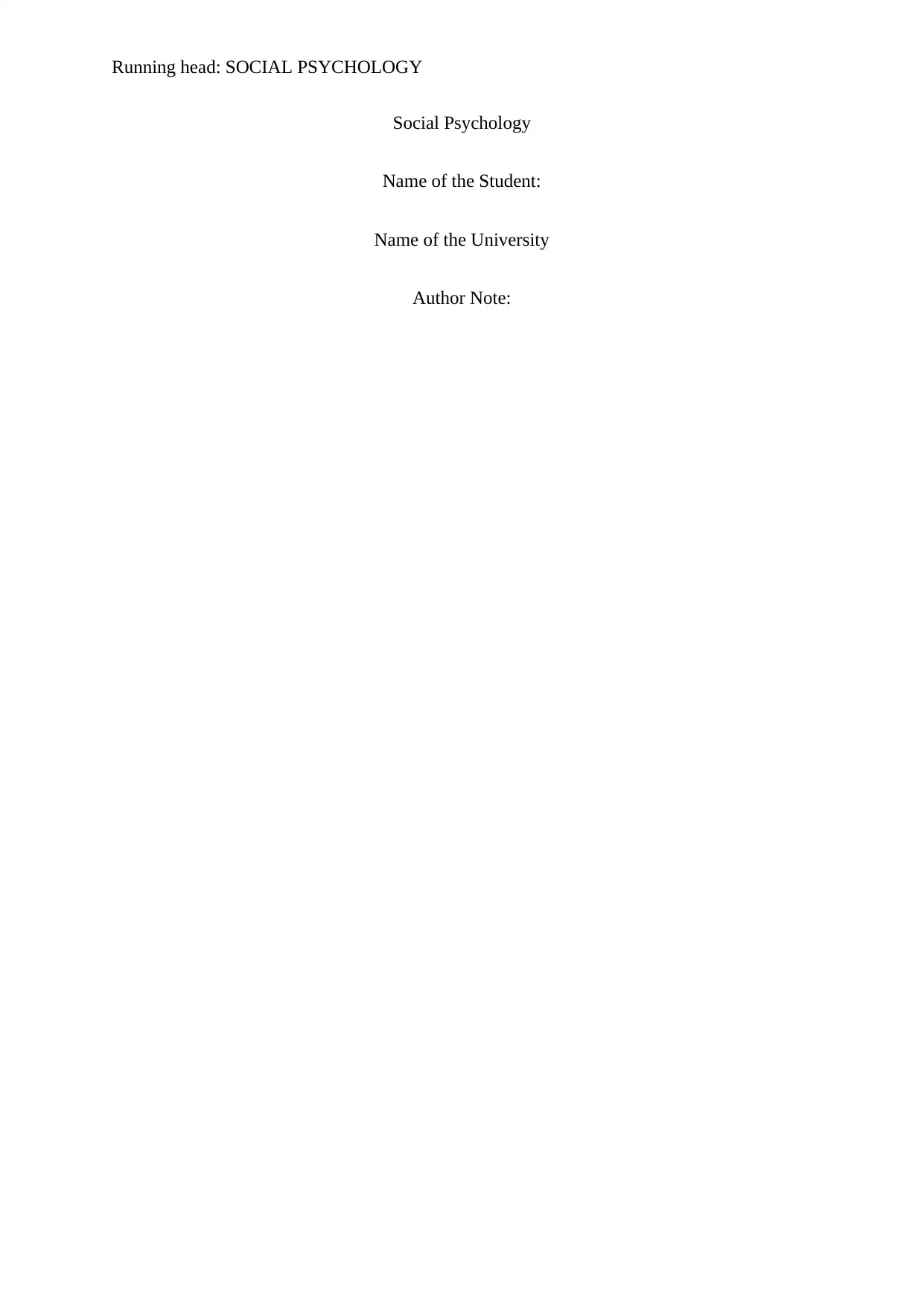
Running head: SOCIAL PSYCHOLOGY
Social Psychology
Name of the Student:
Name of the University
Author Note:
Social Psychology
Name of the Student:
Name of the University
Author Note:
Paraphrase This Document
Need a fresh take? Get an instant paraphrase of this document with our AI Paraphraser
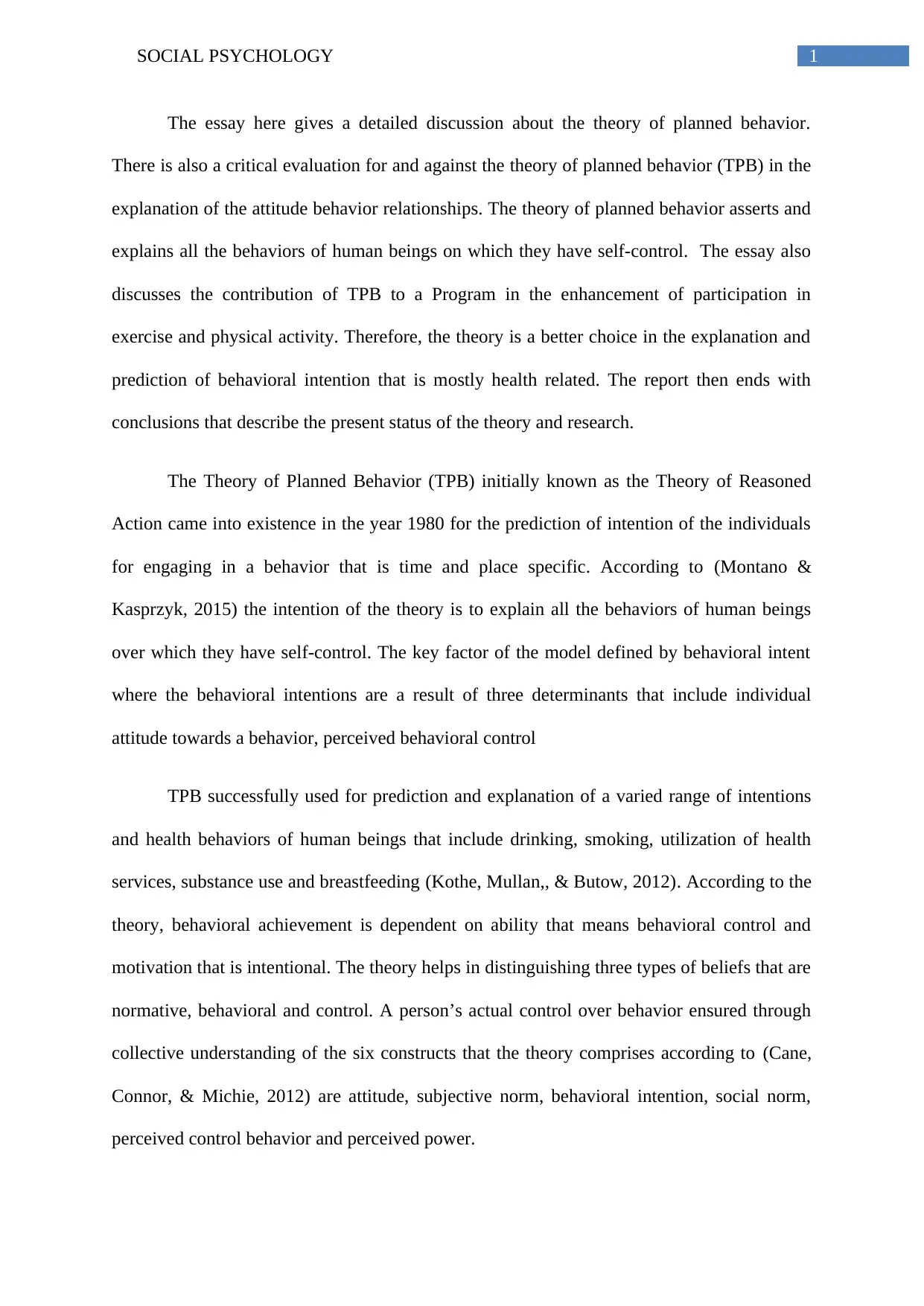
1SOCIAL PSYCHOLOGY
The essay here gives a detailed discussion about the theory of planned behavior.
There is also a critical evaluation for and against the theory of planned behavior (TPB) in the
explanation of the attitude behavior relationships. The theory of planned behavior asserts and
explains all the behaviors of human beings on which they have self-control. The essay also
discusses the contribution of TPB to a Program in the enhancement of participation in
exercise and physical activity. Therefore, the theory is a better choice in the explanation and
prediction of behavioral intention that is mostly health related. The report then ends with
conclusions that describe the present status of the theory and research.
The Theory of Planned Behavior (TPB) initially known as the Theory of Reasoned
Action came into existence in the year 1980 for the prediction of intention of the individuals
for engaging in a behavior that is time and place specific. According to (Montano &
Kasprzyk, 2015) the intention of the theory is to explain all the behaviors of human beings
over which they have self-control. The key factor of the model defined by behavioral intent
where the behavioral intentions are a result of three determinants that include individual
attitude towards a behavior, perceived behavioral control
TPB successfully used for prediction and explanation of a varied range of intentions
and health behaviors of human beings that include drinking, smoking, utilization of health
services, substance use and breastfeeding (Kothe, Mullan,, & Butow, 2012). According to the
theory, behavioral achievement is dependent on ability that means behavioral control and
motivation that is intentional. The theory helps in distinguishing three types of beliefs that are
normative, behavioral and control. A person’s actual control over behavior ensured through
collective understanding of the six constructs that the theory comprises according to (Cane,
Connor, & Michie, 2012) are attitude, subjective norm, behavioral intention, social norm,
perceived control behavior and perceived power.
The essay here gives a detailed discussion about the theory of planned behavior.
There is also a critical evaluation for and against the theory of planned behavior (TPB) in the
explanation of the attitude behavior relationships. The theory of planned behavior asserts and
explains all the behaviors of human beings on which they have self-control. The essay also
discusses the contribution of TPB to a Program in the enhancement of participation in
exercise and physical activity. Therefore, the theory is a better choice in the explanation and
prediction of behavioral intention that is mostly health related. The report then ends with
conclusions that describe the present status of the theory and research.
The Theory of Planned Behavior (TPB) initially known as the Theory of Reasoned
Action came into existence in the year 1980 for the prediction of intention of the individuals
for engaging in a behavior that is time and place specific. According to (Montano &
Kasprzyk, 2015) the intention of the theory is to explain all the behaviors of human beings
over which they have self-control. The key factor of the model defined by behavioral intent
where the behavioral intentions are a result of three determinants that include individual
attitude towards a behavior, perceived behavioral control
TPB successfully used for prediction and explanation of a varied range of intentions
and health behaviors of human beings that include drinking, smoking, utilization of health
services, substance use and breastfeeding (Kothe, Mullan,, & Butow, 2012). According to the
theory, behavioral achievement is dependent on ability that means behavioral control and
motivation that is intentional. The theory helps in distinguishing three types of beliefs that are
normative, behavioral and control. A person’s actual control over behavior ensured through
collective understanding of the six constructs that the theory comprises according to (Cane,
Connor, & Michie, 2012) are attitude, subjective norm, behavioral intention, social norm,
perceived control behavior and perceived power.
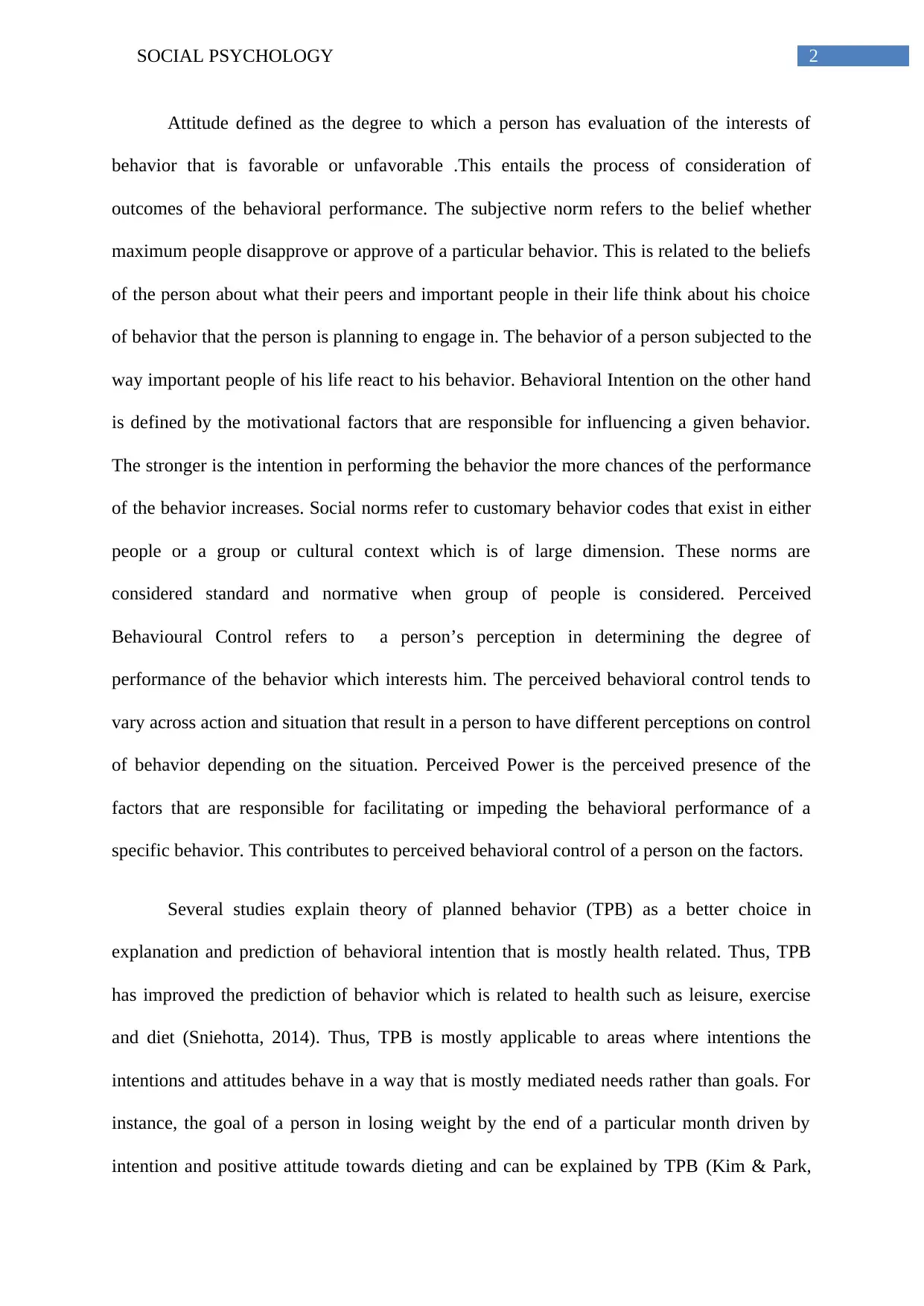
2SOCIAL PSYCHOLOGY
Attitude defined as the degree to which a person has evaluation of the interests of
behavior that is favorable or unfavorable .This entails the process of consideration of
outcomes of the behavioral performance. The subjective norm refers to the belief whether
maximum people disapprove or approve of a particular behavior. This is related to the beliefs
of the person about what their peers and important people in their life think about his choice
of behavior that the person is planning to engage in. The behavior of a person subjected to the
way important people of his life react to his behavior. Behavioral Intention on the other hand
is defined by the motivational factors that are responsible for influencing a given behavior.
The stronger is the intention in performing the behavior the more chances of the performance
of the behavior increases. Social norms refer to customary behavior codes that exist in either
people or a group or cultural context which is of large dimension. These norms are
considered standard and normative when group of people is considered. Perceived
Behavioural Control refers to a person’s perception in determining the degree of
performance of the behavior which interests him. The perceived behavioral control tends to
vary across action and situation that result in a person to have different perceptions on control
of behavior depending on the situation. Perceived Power is the perceived presence of the
factors that are responsible for facilitating or impeding the behavioral performance of a
specific behavior. This contributes to perceived behavioral control of a person on the factors.
Several studies explain theory of planned behavior (TPB) as a better choice in
explanation and prediction of behavioral intention that is mostly health related. Thus, TPB
has improved the prediction of behavior which is related to health such as leisure, exercise
and diet (Sniehotta, 2014). Thus, TPB is mostly applicable to areas where intentions the
intentions and attitudes behave in a way that is mostly mediated needs rather than goals. For
instance, the goal of a person in losing weight by the end of a particular month driven by
intention and positive attitude towards dieting and can be explained by TPB (Kim & Park,
Attitude defined as the degree to which a person has evaluation of the interests of
behavior that is favorable or unfavorable .This entails the process of consideration of
outcomes of the behavioral performance. The subjective norm refers to the belief whether
maximum people disapprove or approve of a particular behavior. This is related to the beliefs
of the person about what their peers and important people in their life think about his choice
of behavior that the person is planning to engage in. The behavior of a person subjected to the
way important people of his life react to his behavior. Behavioral Intention on the other hand
is defined by the motivational factors that are responsible for influencing a given behavior.
The stronger is the intention in performing the behavior the more chances of the performance
of the behavior increases. Social norms refer to customary behavior codes that exist in either
people or a group or cultural context which is of large dimension. These norms are
considered standard and normative when group of people is considered. Perceived
Behavioural Control refers to a person’s perception in determining the degree of
performance of the behavior which interests him. The perceived behavioral control tends to
vary across action and situation that result in a person to have different perceptions on control
of behavior depending on the situation. Perceived Power is the perceived presence of the
factors that are responsible for facilitating or impeding the behavioral performance of a
specific behavior. This contributes to perceived behavioral control of a person on the factors.
Several studies explain theory of planned behavior (TPB) as a better choice in
explanation and prediction of behavioral intention that is mostly health related. Thus, TPB
has improved the prediction of behavior which is related to health such as leisure, exercise
and diet (Sniehotta, 2014). Thus, TPB is mostly applicable to areas where intentions the
intentions and attitudes behave in a way that is mostly mediated needs rather than goals. For
instance, the goal of a person in losing weight by the end of a particular month driven by
intention and positive attitude towards dieting and can be explained by TPB (Kim & Park,
⊘ This is a preview!⊘
Do you want full access?
Subscribe today to unlock all pages.

Trusted by 1+ million students worldwide
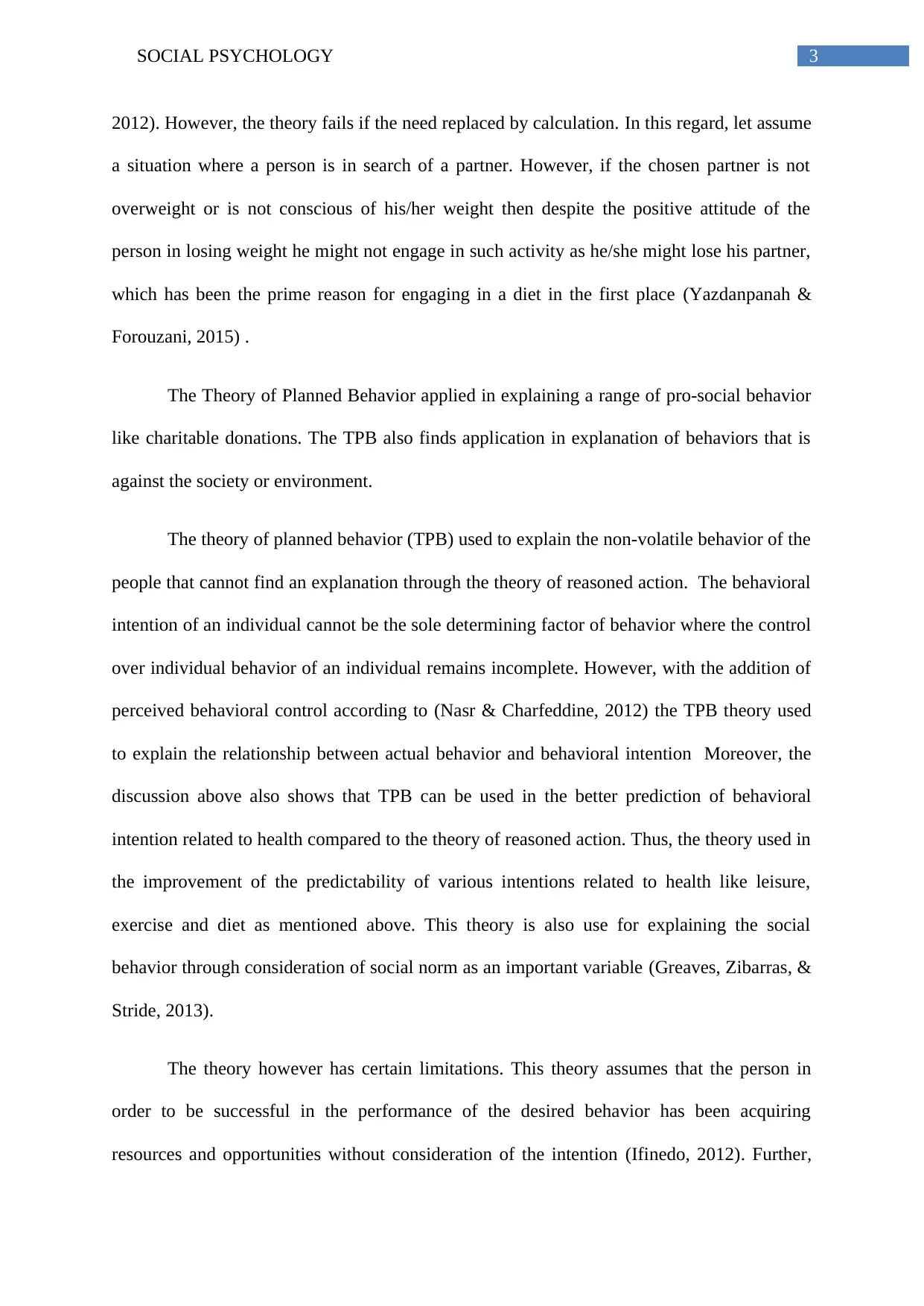
3SOCIAL PSYCHOLOGY
2012). However, the theory fails if the need replaced by calculation. In this regard, let assume
a situation where a person is in search of a partner. However, if the chosen partner is not
overweight or is not conscious of his/her weight then despite the positive attitude of the
person in losing weight he might not engage in such activity as he/she might lose his partner,
which has been the prime reason for engaging in a diet in the first place (Yazdanpanah &
Forouzani, 2015) .
The Theory of Planned Behavior applied in explaining a range of pro-social behavior
like charitable donations. The TPB also finds application in explanation of behaviors that is
against the society or environment.
The theory of planned behavior (TPB) used to explain the non-volatile behavior of the
people that cannot find an explanation through the theory of reasoned action. The behavioral
intention of an individual cannot be the sole determining factor of behavior where the control
over individual behavior of an individual remains incomplete. However, with the addition of
perceived behavioral control according to (Nasr & Charfeddine, 2012) the TPB theory used
to explain the relationship between actual behavior and behavioral intention Moreover, the
discussion above also shows that TPB can be used in the better prediction of behavioral
intention related to health compared to the theory of reasoned action. Thus, the theory used in
the improvement of the predictability of various intentions related to health like leisure,
exercise and diet as mentioned above. This theory is also use for explaining the social
behavior through consideration of social norm as an important variable (Greaves, Zibarras, &
Stride, 2013).
The theory however has certain limitations. This theory assumes that the person in
order to be successful in the performance of the desired behavior has been acquiring
resources and opportunities without consideration of the intention (Ifinedo, 2012). Further,
2012). However, the theory fails if the need replaced by calculation. In this regard, let assume
a situation where a person is in search of a partner. However, if the chosen partner is not
overweight or is not conscious of his/her weight then despite the positive attitude of the
person in losing weight he might not engage in such activity as he/she might lose his partner,
which has been the prime reason for engaging in a diet in the first place (Yazdanpanah &
Forouzani, 2015) .
The Theory of Planned Behavior applied in explaining a range of pro-social behavior
like charitable donations. The TPB also finds application in explanation of behaviors that is
against the society or environment.
The theory of planned behavior (TPB) used to explain the non-volatile behavior of the
people that cannot find an explanation through the theory of reasoned action. The behavioral
intention of an individual cannot be the sole determining factor of behavior where the control
over individual behavior of an individual remains incomplete. However, with the addition of
perceived behavioral control according to (Nasr & Charfeddine, 2012) the TPB theory used
to explain the relationship between actual behavior and behavioral intention Moreover, the
discussion above also shows that TPB can be used in the better prediction of behavioral
intention related to health compared to the theory of reasoned action. Thus, the theory used in
the improvement of the predictability of various intentions related to health like leisure,
exercise and diet as mentioned above. This theory is also use for explaining the social
behavior through consideration of social norm as an important variable (Greaves, Zibarras, &
Stride, 2013).
The theory however has certain limitations. This theory assumes that the person in
order to be successful in the performance of the desired behavior has been acquiring
resources and opportunities without consideration of the intention (Ifinedo, 2012). Further,
Paraphrase This Document
Need a fresh take? Get an instant paraphrase of this document with our AI Paraphraser
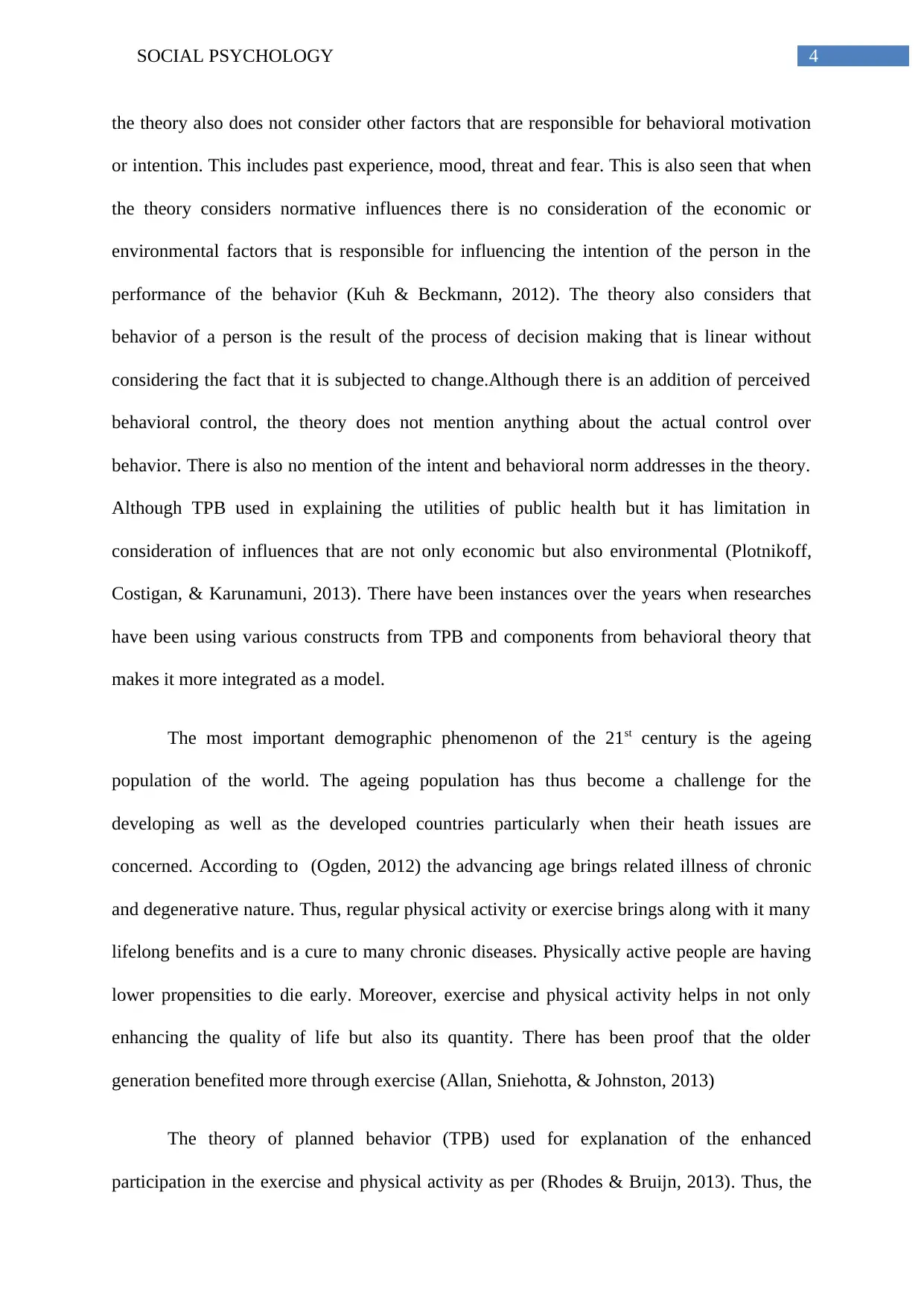
4SOCIAL PSYCHOLOGY
the theory also does not consider other factors that are responsible for behavioral motivation
or intention. This includes past experience, mood, threat and fear. This is also seen that when
the theory considers normative influences there is no consideration of the economic or
environmental factors that is responsible for influencing the intention of the person in the
performance of the behavior (Kuh & Beckmann, 2012). The theory also considers that
behavior of a person is the result of the process of decision making that is linear without
considering the fact that it is subjected to change.Although there is an addition of perceived
behavioral control, the theory does not mention anything about the actual control over
behavior. There is also no mention of the intent and behavioral norm addresses in the theory.
Although TPB used in explaining the utilities of public health but it has limitation in
consideration of influences that are not only economic but also environmental (Plotnikoff,
Costigan, & Karunamuni, 2013). There have been instances over the years when researches
have been using various constructs from TPB and components from behavioral theory that
makes it more integrated as a model.
The most important demographic phenomenon of the 21st century is the ageing
population of the world. The ageing population has thus become a challenge for the
developing as well as the developed countries particularly when their heath issues are
concerned. According to (Ogden, 2012) the advancing age brings related illness of chronic
and degenerative nature. Thus, regular physical activity or exercise brings along with it many
lifelong benefits and is a cure to many chronic diseases. Physically active people are having
lower propensities to die early. Moreover, exercise and physical activity helps in not only
enhancing the quality of life but also its quantity. There has been proof that the older
generation benefited more through exercise (Allan, Sniehotta, & Johnston, 2013)
The theory of planned behavior (TPB) used for explanation of the enhanced
participation in the exercise and physical activity as per (Rhodes & Bruijn, 2013). Thus, the
the theory also does not consider other factors that are responsible for behavioral motivation
or intention. This includes past experience, mood, threat and fear. This is also seen that when
the theory considers normative influences there is no consideration of the economic or
environmental factors that is responsible for influencing the intention of the person in the
performance of the behavior (Kuh & Beckmann, 2012). The theory also considers that
behavior of a person is the result of the process of decision making that is linear without
considering the fact that it is subjected to change.Although there is an addition of perceived
behavioral control, the theory does not mention anything about the actual control over
behavior. There is also no mention of the intent and behavioral norm addresses in the theory.
Although TPB used in explaining the utilities of public health but it has limitation in
consideration of influences that are not only economic but also environmental (Plotnikoff,
Costigan, & Karunamuni, 2013). There have been instances over the years when researches
have been using various constructs from TPB and components from behavioral theory that
makes it more integrated as a model.
The most important demographic phenomenon of the 21st century is the ageing
population of the world. The ageing population has thus become a challenge for the
developing as well as the developed countries particularly when their heath issues are
concerned. According to (Ogden, 2012) the advancing age brings related illness of chronic
and degenerative nature. Thus, regular physical activity or exercise brings along with it many
lifelong benefits and is a cure to many chronic diseases. Physically active people are having
lower propensities to die early. Moreover, exercise and physical activity helps in not only
enhancing the quality of life but also its quantity. There has been proof that the older
generation benefited more through exercise (Allan, Sniehotta, & Johnston, 2013)
The theory of planned behavior (TPB) used for explanation of the enhanced
participation in the exercise and physical activity as per (Rhodes & Bruijn, 2013). Thus, the
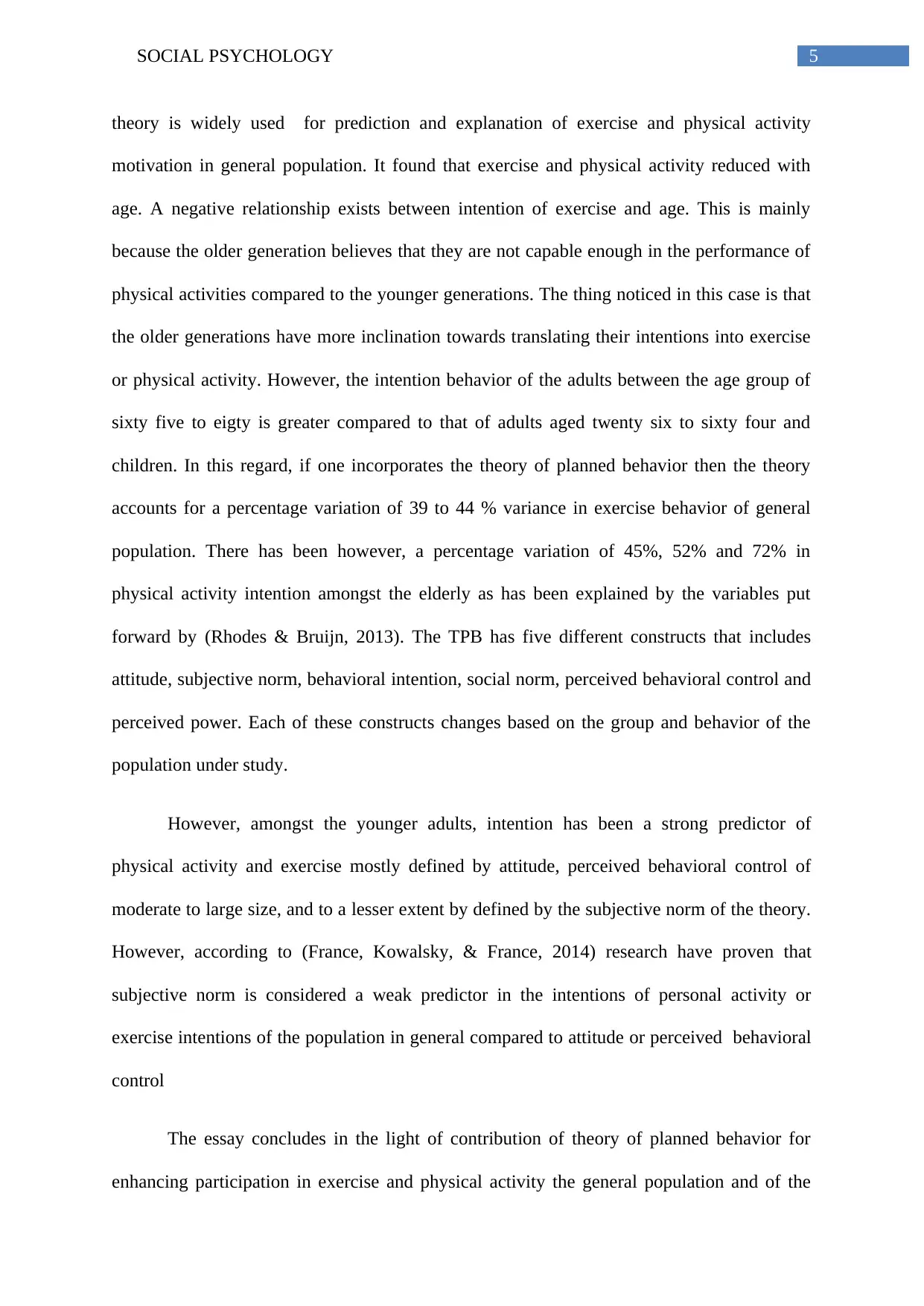
5SOCIAL PSYCHOLOGY
theory is widely used for prediction and explanation of exercise and physical activity
motivation in general population. It found that exercise and physical activity reduced with
age. A negative relationship exists between intention of exercise and age. This is mainly
because the older generation believes that they are not capable enough in the performance of
physical activities compared to the younger generations. The thing noticed in this case is that
the older generations have more inclination towards translating their intentions into exercise
or physical activity. However, the intention behavior of the adults between the age group of
sixty five to eigty is greater compared to that of adults aged twenty six to sixty four and
children. In this regard, if one incorporates the theory of planned behavior then the theory
accounts for a percentage variation of 39 to 44 % variance in exercise behavior of general
population. There has been however, a percentage variation of 45%, 52% and 72% in
physical activity intention amongst the elderly as has been explained by the variables put
forward by (Rhodes & Bruijn, 2013). The TPB has five different constructs that includes
attitude, subjective norm, behavioral intention, social norm, perceived behavioral control and
perceived power. Each of these constructs changes based on the group and behavior of the
population under study.
However, amongst the younger adults, intention has been a strong predictor of
physical activity and exercise mostly defined by attitude, perceived behavioral control of
moderate to large size, and to a lesser extent by defined by the subjective norm of the theory.
However, according to (France, Kowalsky, & France, 2014) research have proven that
subjective norm is considered a weak predictor in the intentions of personal activity or
exercise intentions of the population in general compared to attitude or perceived behavioral
control
The essay concludes in the light of contribution of theory of planned behavior for
enhancing participation in exercise and physical activity the general population and of the
theory is widely used for prediction and explanation of exercise and physical activity
motivation in general population. It found that exercise and physical activity reduced with
age. A negative relationship exists between intention of exercise and age. This is mainly
because the older generation believes that they are not capable enough in the performance of
physical activities compared to the younger generations. The thing noticed in this case is that
the older generations have more inclination towards translating their intentions into exercise
or physical activity. However, the intention behavior of the adults between the age group of
sixty five to eigty is greater compared to that of adults aged twenty six to sixty four and
children. In this regard, if one incorporates the theory of planned behavior then the theory
accounts for a percentage variation of 39 to 44 % variance in exercise behavior of general
population. There has been however, a percentage variation of 45%, 52% and 72% in
physical activity intention amongst the elderly as has been explained by the variables put
forward by (Rhodes & Bruijn, 2013). The TPB has five different constructs that includes
attitude, subjective norm, behavioral intention, social norm, perceived behavioral control and
perceived power. Each of these constructs changes based on the group and behavior of the
population under study.
However, amongst the younger adults, intention has been a strong predictor of
physical activity and exercise mostly defined by attitude, perceived behavioral control of
moderate to large size, and to a lesser extent by defined by the subjective norm of the theory.
However, according to (France, Kowalsky, & France, 2014) research have proven that
subjective norm is considered a weak predictor in the intentions of personal activity or
exercise intentions of the population in general compared to attitude or perceived behavioral
control
The essay concludes in the light of contribution of theory of planned behavior for
enhancing participation in exercise and physical activity the general population and of the
⊘ This is a preview!⊘
Do you want full access?
Subscribe today to unlock all pages.

Trusted by 1+ million students worldwide
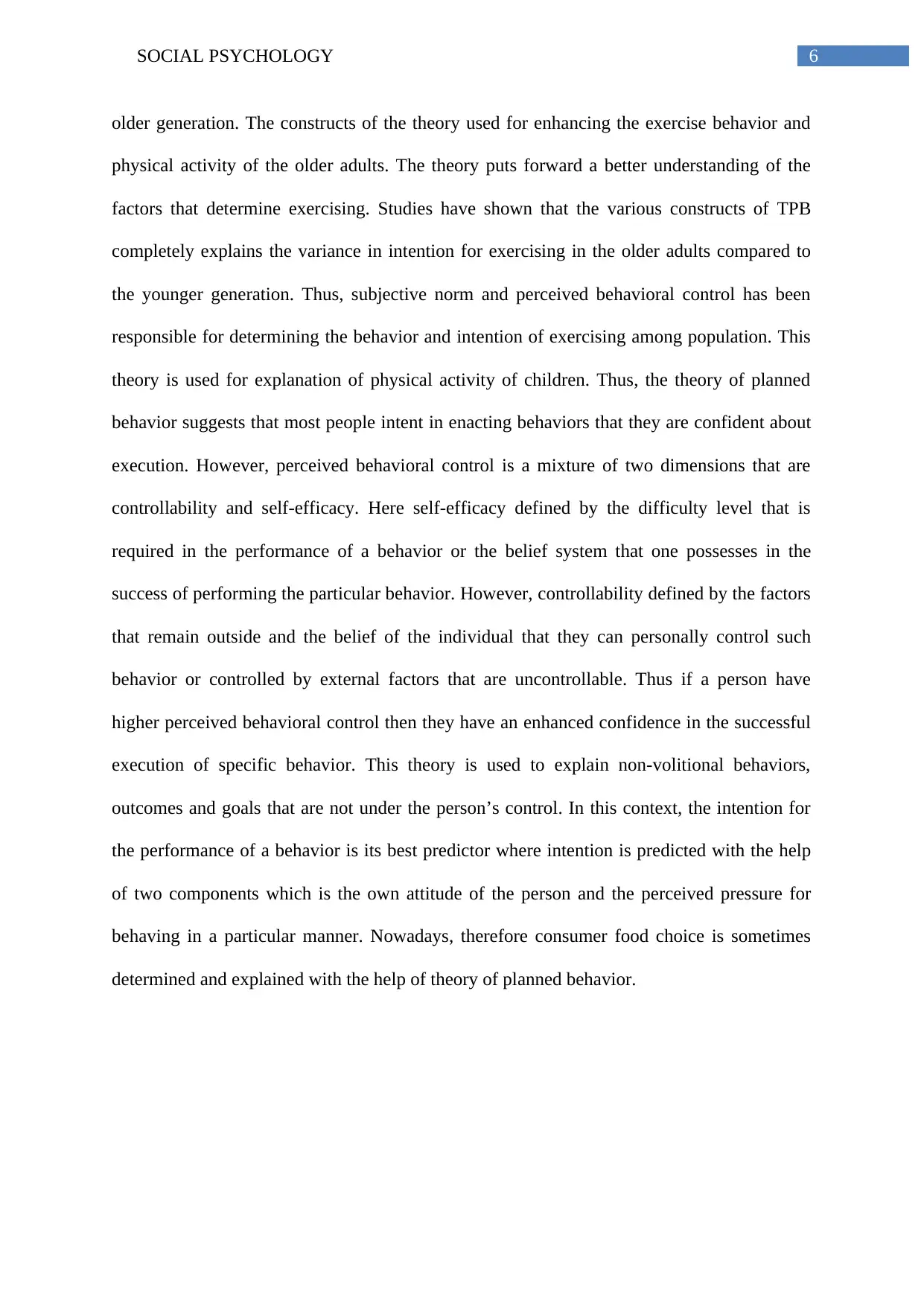
6SOCIAL PSYCHOLOGY
older generation. The constructs of the theory used for enhancing the exercise behavior and
physical activity of the older adults. The theory puts forward a better understanding of the
factors that determine exercising. Studies have shown that the various constructs of TPB
completely explains the variance in intention for exercising in the older adults compared to
the younger generation. Thus, subjective norm and perceived behavioral control has been
responsible for determining the behavior and intention of exercising among population. This
theory is used for explanation of physical activity of children. Thus, the theory of planned
behavior suggests that most people intent in enacting behaviors that they are confident about
execution. However, perceived behavioral control is a mixture of two dimensions that are
controllability and self-efficacy. Here self-efficacy defined by the difficulty level that is
required in the performance of a behavior or the belief system that one possesses in the
success of performing the particular behavior. However, controllability defined by the factors
that remain outside and the belief of the individual that they can personally control such
behavior or controlled by external factors that are uncontrollable. Thus if a person have
higher perceived behavioral control then they have an enhanced confidence in the successful
execution of specific behavior. This theory is used to explain non-volitional behaviors,
outcomes and goals that are not under the person’s control. In this context, the intention for
the performance of a behavior is its best predictor where intention is predicted with the help
of two components which is the own attitude of the person and the perceived pressure for
behaving in a particular manner. Nowadays, therefore consumer food choice is sometimes
determined and explained with the help of theory of planned behavior.
older generation. The constructs of the theory used for enhancing the exercise behavior and
physical activity of the older adults. The theory puts forward a better understanding of the
factors that determine exercising. Studies have shown that the various constructs of TPB
completely explains the variance in intention for exercising in the older adults compared to
the younger generation. Thus, subjective norm and perceived behavioral control has been
responsible for determining the behavior and intention of exercising among population. This
theory is used for explanation of physical activity of children. Thus, the theory of planned
behavior suggests that most people intent in enacting behaviors that they are confident about
execution. However, perceived behavioral control is a mixture of two dimensions that are
controllability and self-efficacy. Here self-efficacy defined by the difficulty level that is
required in the performance of a behavior or the belief system that one possesses in the
success of performing the particular behavior. However, controllability defined by the factors
that remain outside and the belief of the individual that they can personally control such
behavior or controlled by external factors that are uncontrollable. Thus if a person have
higher perceived behavioral control then they have an enhanced confidence in the successful
execution of specific behavior. This theory is used to explain non-volitional behaviors,
outcomes and goals that are not under the person’s control. In this context, the intention for
the performance of a behavior is its best predictor where intention is predicted with the help
of two components which is the own attitude of the person and the perceived pressure for
behaving in a particular manner. Nowadays, therefore consumer food choice is sometimes
determined and explained with the help of theory of planned behavior.
Paraphrase This Document
Need a fresh take? Get an instant paraphrase of this document with our AI Paraphraser
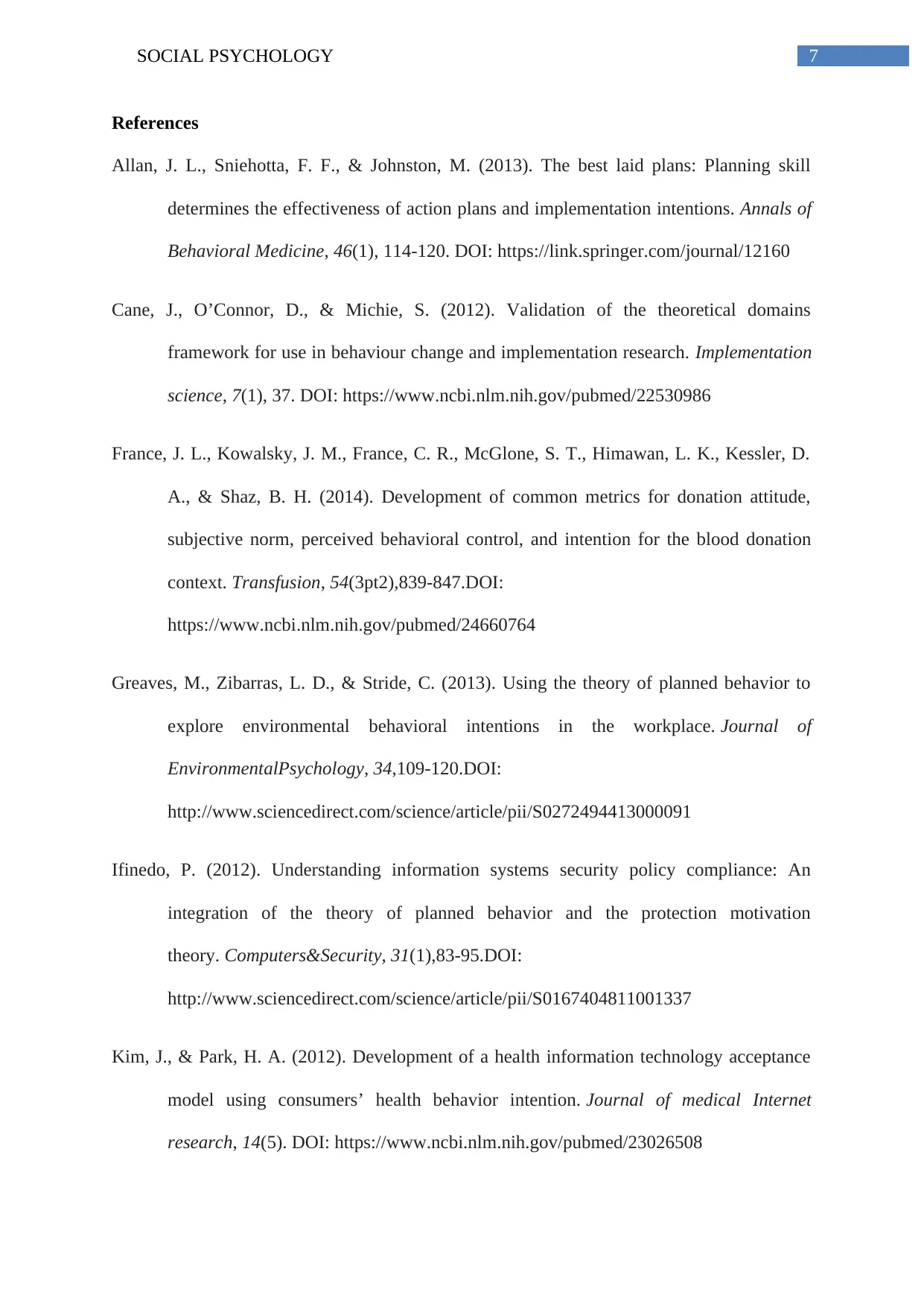
7SOCIAL PSYCHOLOGY
References
Allan, J. L., Sniehotta, F. F., & Johnston, M. (2013). The best laid plans: Planning skill
determines the effectiveness of action plans and implementation intentions. Annals of
Behavioral Medicine, 46(1), 114-120. DOI: https://link.springer.com/journal/12160
Cane, J., O’Connor, D., & Michie, S. (2012). Validation of the theoretical domains
framework for use in behaviour change and implementation research. Implementation
science, 7(1), 37. DOI: https://www.ncbi.nlm.nih.gov/pubmed/22530986
France, J. L., Kowalsky, J. M., France, C. R., McGlone, S. T., Himawan, L. K., Kessler, D.
A., & Shaz, B. H. (2014). Development of common metrics for donation attitude,
subjective norm, perceived behavioral control, and intention for the blood donation
context. Transfusion, 54(3pt2),839-847.DOI:
https://www.ncbi.nlm.nih.gov/pubmed/24660764
Greaves, M., Zibarras, L. D., & Stride, C. (2013). Using the theory of planned behavior to
explore environmental behavioral intentions in the workplace. Journal of
EnvironmentalPsychology, 34,109-120.DOI:
http://www.sciencedirect.com/science/article/pii/S0272494413000091
Ifinedo, P. (2012). Understanding information systems security policy compliance: An
integration of the theory of planned behavior and the protection motivation
theory. Computers&Security, 31(1),83-95.DOI:
http://www.sciencedirect.com/science/article/pii/S0167404811001337
Kim, J., & Park, H. A. (2012). Development of a health information technology acceptance
model using consumers’ health behavior intention. Journal of medical Internet
research, 14(5). DOI: https://www.ncbi.nlm.nih.gov/pubmed/23026508
References
Allan, J. L., Sniehotta, F. F., & Johnston, M. (2013). The best laid plans: Planning skill
determines the effectiveness of action plans and implementation intentions. Annals of
Behavioral Medicine, 46(1), 114-120. DOI: https://link.springer.com/journal/12160
Cane, J., O’Connor, D., & Michie, S. (2012). Validation of the theoretical domains
framework for use in behaviour change and implementation research. Implementation
science, 7(1), 37. DOI: https://www.ncbi.nlm.nih.gov/pubmed/22530986
France, J. L., Kowalsky, J. M., France, C. R., McGlone, S. T., Himawan, L. K., Kessler, D.
A., & Shaz, B. H. (2014). Development of common metrics for donation attitude,
subjective norm, perceived behavioral control, and intention for the blood donation
context. Transfusion, 54(3pt2),839-847.DOI:
https://www.ncbi.nlm.nih.gov/pubmed/24660764
Greaves, M., Zibarras, L. D., & Stride, C. (2013). Using the theory of planned behavior to
explore environmental behavioral intentions in the workplace. Journal of
EnvironmentalPsychology, 34,109-120.DOI:
http://www.sciencedirect.com/science/article/pii/S0272494413000091
Ifinedo, P. (2012). Understanding information systems security policy compliance: An
integration of the theory of planned behavior and the protection motivation
theory. Computers&Security, 31(1),83-95.DOI:
http://www.sciencedirect.com/science/article/pii/S0167404811001337
Kim, J., & Park, H. A. (2012). Development of a health information technology acceptance
model using consumers’ health behavior intention. Journal of medical Internet
research, 14(5). DOI: https://www.ncbi.nlm.nih.gov/pubmed/23026508
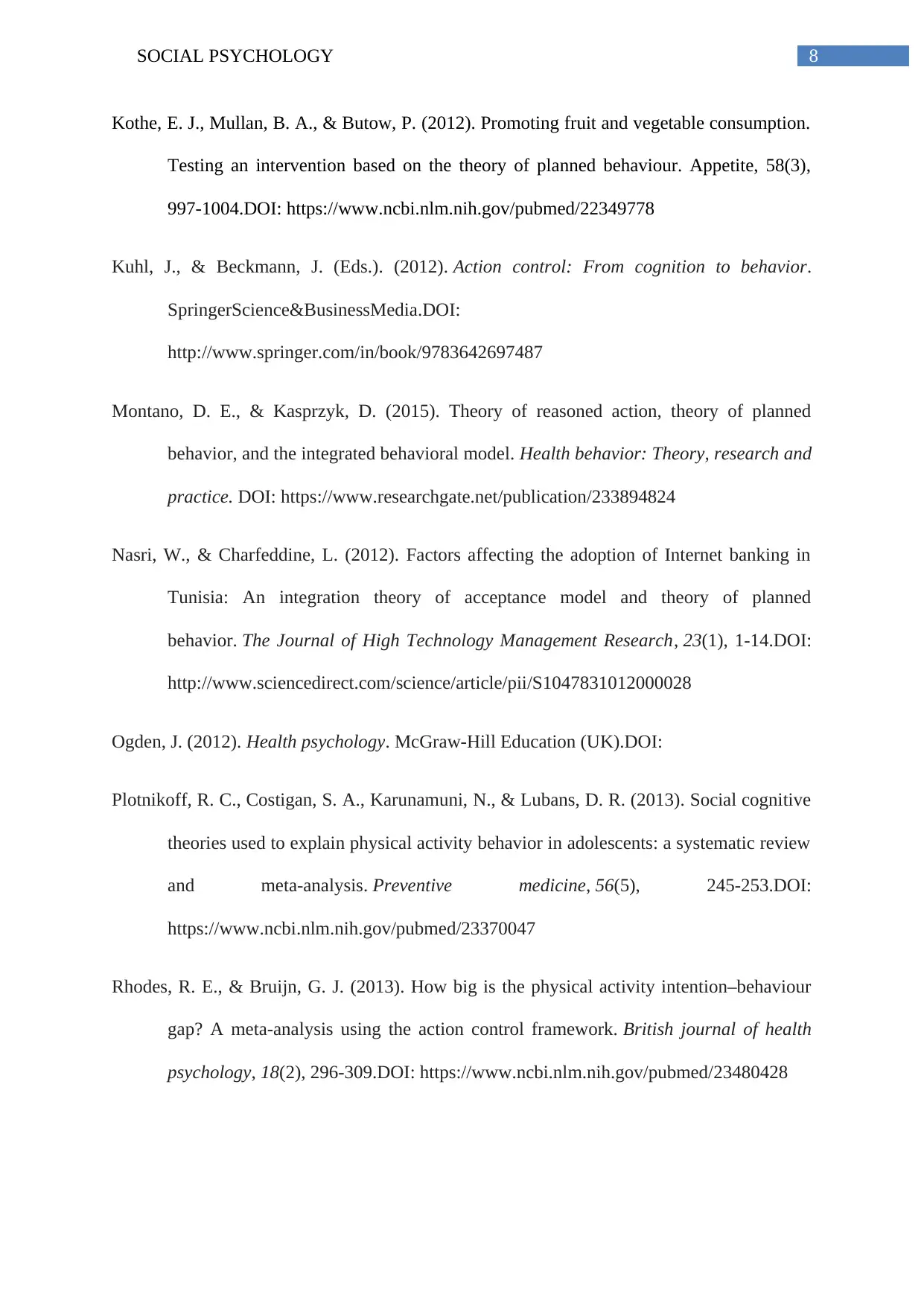
8SOCIAL PSYCHOLOGY
Kothe, E. J., Mullan, B. A., & Butow, P. (2012). Promoting fruit and vegetable consumption.
Testing an intervention based on the theory of planned behaviour. Appetite, 58(3),
997-1004.DOI: https://www.ncbi.nlm.nih.gov/pubmed/22349778
Kuhl, J., & Beckmann, J. (Eds.). (2012). Action control: From cognition to behavior.
SpringerScience&BusinessMedia.DOI:
http://www.springer.com/in/book/9783642697487
Montano, D. E., & Kasprzyk, D. (2015). Theory of reasoned action, theory of planned
behavior, and the integrated behavioral model. Health behavior: Theory, research and
practice. DOI: https://www.researchgate.net/publication/233894824
Nasri, W., & Charfeddine, L. (2012). Factors affecting the adoption of Internet banking in
Tunisia: An integration theory of acceptance model and theory of planned
behavior. The Journal of High Technology Management Research, 23(1), 1-14.DOI:
http://www.sciencedirect.com/science/article/pii/S1047831012000028
Ogden, J. (2012). Health psychology. McGraw-Hill Education (UK).DOI:
Plotnikoff, R. C., Costigan, S. A., Karunamuni, N., & Lubans, D. R. (2013). Social cognitive
theories used to explain physical activity behavior in adolescents: a systematic review
and meta-analysis. Preventive medicine, 56(5), 245-253.DOI:
https://www.ncbi.nlm.nih.gov/pubmed/23370047
Rhodes, R. E., & Bruijn, G. J. (2013). How big is the physical activity intention–behaviour
gap? A meta‐analysis using the action control framework. British journal of health
psychology, 18(2), 296-309.DOI: https://www.ncbi.nlm.nih.gov/pubmed/23480428
Kothe, E. J., Mullan, B. A., & Butow, P. (2012). Promoting fruit and vegetable consumption.
Testing an intervention based on the theory of planned behaviour. Appetite, 58(3),
997-1004.DOI: https://www.ncbi.nlm.nih.gov/pubmed/22349778
Kuhl, J., & Beckmann, J. (Eds.). (2012). Action control: From cognition to behavior.
SpringerScience&BusinessMedia.DOI:
http://www.springer.com/in/book/9783642697487
Montano, D. E., & Kasprzyk, D. (2015). Theory of reasoned action, theory of planned
behavior, and the integrated behavioral model. Health behavior: Theory, research and
practice. DOI: https://www.researchgate.net/publication/233894824
Nasri, W., & Charfeddine, L. (2012). Factors affecting the adoption of Internet banking in
Tunisia: An integration theory of acceptance model and theory of planned
behavior. The Journal of High Technology Management Research, 23(1), 1-14.DOI:
http://www.sciencedirect.com/science/article/pii/S1047831012000028
Ogden, J. (2012). Health psychology. McGraw-Hill Education (UK).DOI:
Plotnikoff, R. C., Costigan, S. A., Karunamuni, N., & Lubans, D. R. (2013). Social cognitive
theories used to explain physical activity behavior in adolescents: a systematic review
and meta-analysis. Preventive medicine, 56(5), 245-253.DOI:
https://www.ncbi.nlm.nih.gov/pubmed/23370047
Rhodes, R. E., & Bruijn, G. J. (2013). How big is the physical activity intention–behaviour
gap? A meta‐analysis using the action control framework. British journal of health
psychology, 18(2), 296-309.DOI: https://www.ncbi.nlm.nih.gov/pubmed/23480428
⊘ This is a preview!⊘
Do you want full access?
Subscribe today to unlock all pages.

Trusted by 1+ million students worldwide
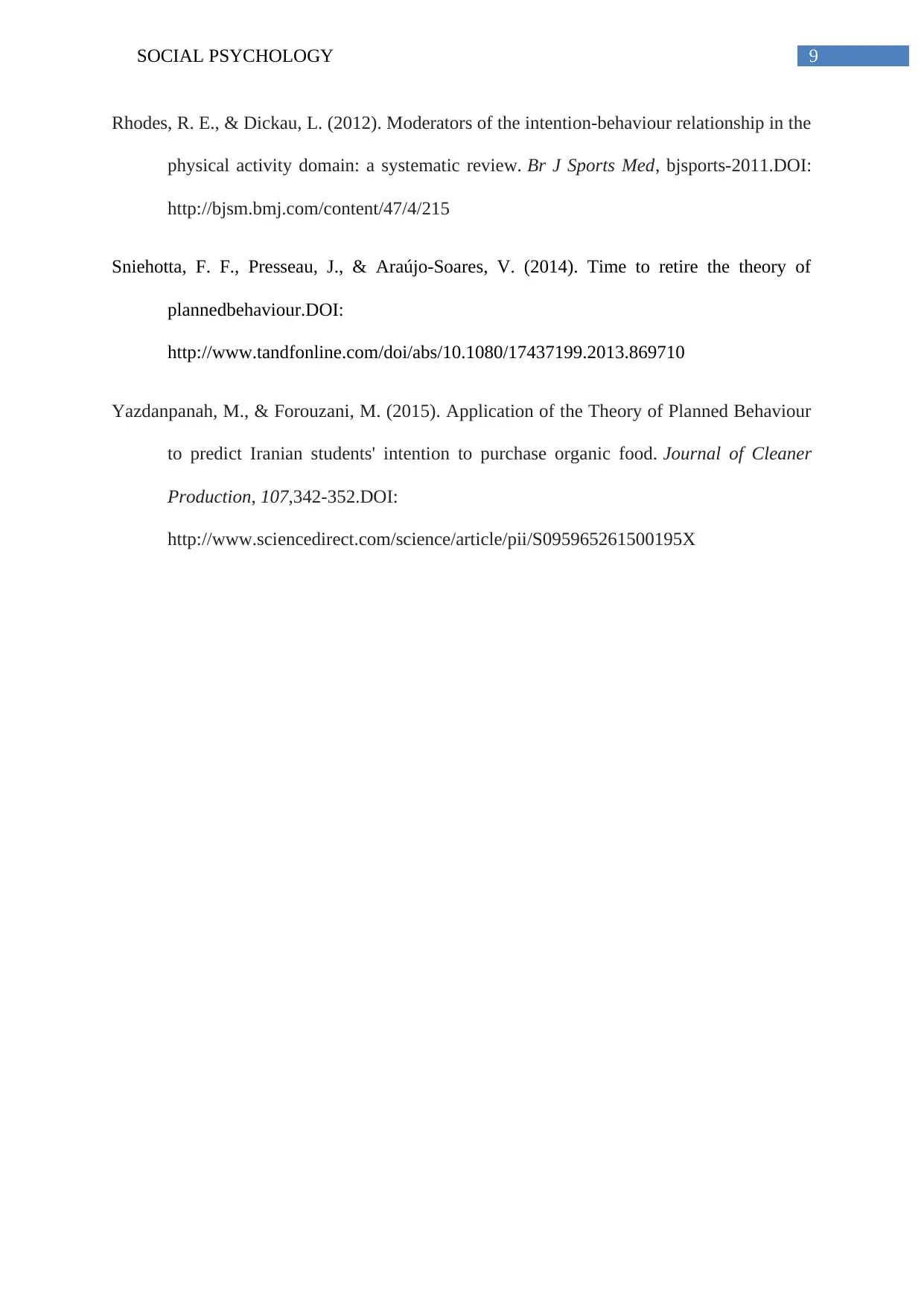
9SOCIAL PSYCHOLOGY
Rhodes, R. E., & Dickau, L. (2012). Moderators of the intention-behaviour relationship in the
physical activity domain: a systematic review. Br J Sports Med, bjsports-2011.DOI:
http://bjsm.bmj.com/content/47/4/215
Sniehotta, F. F., Presseau, J., & Araújo-Soares, V. (2014). Time to retire the theory of
plannedbehaviour.DOI:
http://www.tandfonline.com/doi/abs/10.1080/17437199.2013.869710
Yazdanpanah, M., & Forouzani, M. (2015). Application of the Theory of Planned Behaviour
to predict Iranian students' intention to purchase organic food. Journal of Cleaner
Production, 107,342-352.DOI:
http://www.sciencedirect.com/science/article/pii/S095965261500195X
Rhodes, R. E., & Dickau, L. (2012). Moderators of the intention-behaviour relationship in the
physical activity domain: a systematic review. Br J Sports Med, bjsports-2011.DOI:
http://bjsm.bmj.com/content/47/4/215
Sniehotta, F. F., Presseau, J., & Araújo-Soares, V. (2014). Time to retire the theory of
plannedbehaviour.DOI:
http://www.tandfonline.com/doi/abs/10.1080/17437199.2013.869710
Yazdanpanah, M., & Forouzani, M. (2015). Application of the Theory of Planned Behaviour
to predict Iranian students' intention to purchase organic food. Journal of Cleaner
Production, 107,342-352.DOI:
http://www.sciencedirect.com/science/article/pii/S095965261500195X
1 out of 10
Related Documents
Your All-in-One AI-Powered Toolkit for Academic Success.
+13062052269
info@desklib.com
Available 24*7 on WhatsApp / Email
![[object Object]](/_next/static/media/star-bottom.7253800d.svg)
Unlock your academic potential
Copyright © 2020–2025 A2Z Services. All Rights Reserved. Developed and managed by ZUCOL.





